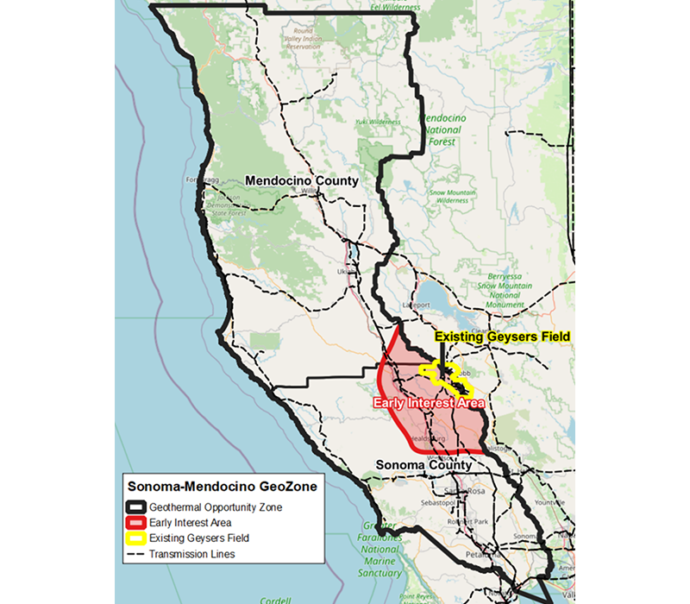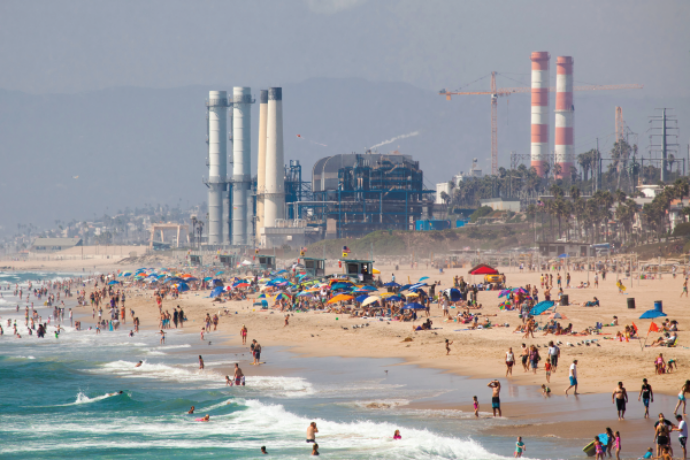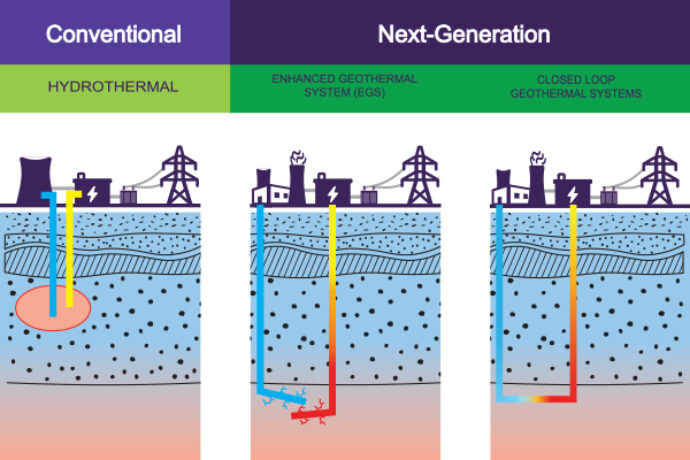Sonoma Clean Power’s initiative to secure affordable, reliable clean energy for our region.
Subscribe to email updatesSonoma Clean Power, in partnership with Sonoma and Mendocino counties, is leading the GeoZone initiative to develop 600 MW of next-generation geothermal energy.
The goal: ensure long-term, affordable, and reliable clean energy for the region while tackling the global climate crisis.
The GeoZone benefits Sonoma and Mendocino counties by providing:

Map of the GeoZone early interest area.
Sonoma Clean Power encourages early and frequent public engagement with our GeoZone effort. Through community presentations, town halls, public meetings, and more, we hope to provide a variety of opportunities for the community to ask questions and establish preferences that can steer the design of new, local geothermal development.
Sonoma Clean Power’s GeoZone partners are required to develop projects that are responsive to our community values. While our partners are taking the lead on the project-specific details, we at Sonoma Clean Power will continue to facilitate public engagement as project locations and technologies are identified.
Please contact us with questions or comments, and sign up for our GeoZone email updates.
SCP gives a GeoZone update at each monthly Community Advisory Committee meeting and welcomes public input.
As California’s energy load grows due to the rise of electric cars, the electrification of buildings, the energy demands associated with artificial intelligence, and more, the need for clean “firm” energy sources, like geothermal, is also quickly growing.
Firm resources are available whenever you need them. They complement the use of solar power, wind energy, and battery storage by steadily producing clean power at night, and through dark periods in the winter, when there is little sun or wind available and batteries are depleted.
To stay on track with our ambitious climate goals, Sonoma Clean Power expects that roughly 40% of our energy will need to come from geothermal resources by 2038.
California regulators have also identified a need for significant growth in this sector, and the California Public Utilities Commission is planning to more than double geothermal capacity by 2035.
Expanding local geothermal capacity will position Sonoma and Mendocino counties as leaders in cleaning up California’s electric grid, and ensure our region reaps the benefits of high-quality jobs and tax revenues.
Energy derived from fossil fuels, such as coal and natural gas, produces greenhouse gases that warm the Earth and drive the climate crisis. Clean energy generated by renewable sources such as solar, wind, and geothermal, helps solve that problem.
California set a goal of producing 100% of its electricity from renewable and zero-carbon sources by 2045. Sonoma Clean Power’s role is to help our region achieve this target quickly and affordably.
Our Dependence on Natural Gas
Despite rapid growth in renewable energy, California has been unable to permanently shut down its dirtiest natural gas power plants. The state still relies on fossil fuels like natural gas to keep the lights on when the sun isn’t shining, wind isn’t blowing, and batteries are depleted – primarily at night and through much of the winter.
Though Sonoma Clean Power’s power mix is significantly cleaner than most electricity providers in California, even we rely heavily on natural gas to keep the lights on at night.
These natural gas plants are a major contributor to the climate crisis, which increases the risk of wildfires, extreme heat, flooding, and drought. Most are located in poorer neighborhoods around the Los Angeles basin, where the disadvantaged communities they are sited in bear the consequences of unhealthy air.
Here in Sonoma and Mendocino counties, we are not directly exposed to these impacts. However, we are exporting our pollution elsewhere to keep the lights on in our region.
The natural gas plants that serve Sonoma Clean Power and power providers throughout the state are also increasingly expensive to maintain – even when they’re only running once in a while, resulting in extremely high costs for all electricity customers.
Because geothermal power can generate clean energy 24/7, it has significant potential to replace natural gas as a reliability resource on a large scale.
If the GeoZone is a success, Sonoma Clean Power can provide 100% clean energy to our customers around-the-clock and stop sending millions of dollars to natural gas power plants.
Limits of Conventional Geothermal
Over the last decade, there has been minimal growth in geothermal capacity in the state. Our region is already home to the Geysers - a world-class geothermal resource - but its existing output is not enough to support the clean energy transition.
In addition, all existing geothermal resources at the Geysers are contracted for, meaning Sonoma Clean Power cannot purchase more energy from their facilities at this time.
The Geysers is special because it sits in a volcanic zone with underground water flowing through permeable rock. Next-gen geothermal has found ways to expand renewable power production in areas without these conditions.
Near-term increases in California’s geothermal capacity will primarily come from Nevada or the Imperial Valley in Southern California. Long-term, the GeoZone is well-positioned to provide a significant amount of geothermal power locally and statewide.

A natural gas power plant in the Los Angeles area.
Conventional geothermal power production works by using underground heat to produce electricity. There are places where magma comes close to the Earth’s surface and warms the solid rock directly above it to very high temperatures.
Conventional geothermal requires three things:
Energy is generated by sending water down a pipe into the field of hot rock and passing it through the rock’s fractures. As the water heats up it creates steam, which comes back up another pipe and powers a turbine to generate electricity.

Conventional versus next-generation geothermal energy production.
In 2022, the GeoZone effort kicked off with Sonoma Clean Power issuing a Request for Information to identify companies with capabilities to deliver next-gen geothermal resources through a public-private partnership in Sonoma and Mendocino counties.
This process was modeled after the partnership established by Redwood Coast Energy Authority (the Sonoma Clean Power equivalent serving Humboldt County) to pursue offshore wind development.
After a comprehensive evaluation process, which included review by industry experts, a local permitting agency, and public stakeholders, the SCP Board of Directors selected three finalists with successful development experience and technologies that met Sonoma Clean Power’s selection criteria, including:
Since then, further advancements in next-generation geothermal have continued to validate Sonoma Clean Power’s interest in these technologies.
In March 2024, the U.S. Department of Energy published a report highlighting research findings that widespread deployment of next-generation geothermal technologies could cut the cost of achieving 100% clean energy in the Western grid by as much as 25%, compared to the status quo.
SCP’s three development partners are Eavor Inc., Chevron New Energies, and Cyrq Energy. Every partner has proposed different next-generation geothermal technologies to test and explore within the GeoZone, each with their own advantages.
To increase the chances for success, Sonoma Clean Power is pursuing multiple emerging technologies and private partners.
Eavor, Inc. plans to pilot an advanced closed-loop geothermal system. This technology involves drilling a closed loop of pipes through a field of solid hot rock under the Earth’s surface to allow water to move through.
Once heated, the water is drawn up to the surface and the heat is extracted to produce electricity. The cooled water is then sent back down to be used again in a closed loop. Because the water stays within the pipe system, this closed loop technology has the potential to use significantly less water than many other energy resources.
Chevron New Energies is aiming to pilot an Enhanced Geothermal Systems (EGS) project. EGS creates pathways for water to move underground, similar to the natural pathways found in conventional geothermal fields, by creating cracks to connect two wells in deep hard rock far below the earth’s surface. Water is pumped through the fractures, heated by the rock, and used to drive an electric turbine at the surface.
Although EGS is a new technology, it is rapidly maturing. This is largely due to improvements in horizontal drilling and hydraulic fracturing technologies from the oil and gas industry. For more information on how EGS is superficially similar to, but significantly different from fracking for oil and gas, please see our EGS attachment.
In early 2024, Chevron New Energies’ GeoZone project was selected to negotiate a grant award from the Department of Energy’s Geothermal Technology Office to help fund early GeoZone demonstration activities.
Cyrq Energy plans to deploy thermal energy storage technology at existing geothermal power plants at the Geysers to improve their flexibility and reliability. In short, this storage would enable conventional geothermal systems to produce more power when we need it, and less when we have other renewable sources in abundance.
During the day when there is ample solar power on the grid, instead of producing electricity, the geothermal system charges up Cyrq’s thermal energy storage composed of concrete blocks. In the evening, when solar generation drops but energy consumption increases (as people come home and turn on their lights and appliances), the stored heat is used to superheat steam entering the geothermal plant, increasing the system’s output by about 45%.
GeoZone initiative materials, including creation resolutions, partner solicitations, agency agreements, webinars, and interviews.